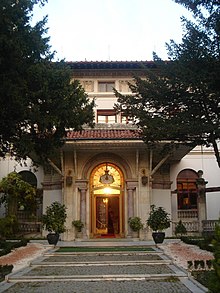Khedive Palace
The Khedive Palace ( Turkish Hidiv Kasrı ) or Çubuklu Palace ( Turkish Çubuklu Sarayı ) in Istanbul is the former palace of the Khedive Abbas II of Egypt and Sudan . The palace is sometimes referred to as the Khedive Pavilion or the Khedive House .
location
The palace is located north of the Fatih Sultan Mehmet Bridge on a hill on the Bosphorus in the Çubuklu district in Istanbul's Beykoz district and is surrounded by a 110- hectare forest.
history
Abbas II (reign 1892-1914) was the last khedive in Egypt. Unlike his predecessors, he maintained good relations with the Ottoman Sultan, whose rule over the khedivat had been more formal since the liberation struggle of Muhammad Ali Pasha in 1805 and Egypt was a sub-state of the Ottoman Empire, but in fact a protectorate of the United Kingdom. Abbas II saw the connection to the Ottoman Empire as an opportunity to undermine the British protectorate. Part of his efforts to improve relations with the Sublime Porte were several visits to Constantinople . He also commissioned the Italian architect Delfo Seminati to build a summer residence on the Bosporus.
The palace was built in 1907 in the Art Nouveau style and is mainly influenced by the Italian villas of the Renaissance , but also has characteristic elements of neoclassical Ottoman architecture. The beloved and secret second wife of Abbas II, the Hungarian Countess May Török von Szendrő (also Djavidan Hanum ), described in her autobiography Harem that the decoration of the palace was based on her ideas. She also had the palace gardens with the trees, the rose garden and the footpaths through the grove laid out.
An identical copy of the palace was built on the banks of the Nile in Egypt.
At the behest of the founder and first President of Turkey Mustafa Kemal Ataturk , the city of Istanbul acquired the palace in 1937. However, the building was empty until the 1980s. The Turkish Automobile Club Türkiye Turing ve Otomobil Kurumu (TTOK) signed a contract with the city administration in 1979 to restore some of the old Ottoman residences and gardens and market them as tourist destinations. Within these framework agreements, the organization under its general director Çelik Gülersoy had the abandoned palace renovated over the next two years. In 1984 the Khedive Palace was opened to the public.
The premises were managed by the TTOK for ten years and taken over in 1994 by the Istanbul City Council, which had not renewed the contract with the automobile club. The building was extensively restored from 2014 to 2016.
The hotel is closed today, the restaurant and café still exist. The building can also be visited.
architecture
The two-storey building with a low and lavishly decorated attic storey was erected over a quarter-circle floor plan. Corner projections structure the facades. There is a large fountain in the atrium . The northern facade is rounded in a quarter circle with a narrow portico on the ground floor. On the west side there is a tower with a square floor plan, opposite a lower tower. An extensive garden with a terrace made of marble slabs extends to the southeast. The residence's rose garden is the largest in Istanbul.
The inner central halls functioned as a restaurant, the upper floors as a hotel and the marble hall and garden housed a café. The hotel could accommodate meetings for up to 1000 people in the summer and offered cocktail receptions for up to 1500 people. In the winter months, conferences for up to 450 people and receptions for up to 700 guests were possible.
On the ground floor of the 1000 m² palace there is a central hall that connects the surrounding rooms and halls. One of the larger halls on the ground floor has a large fireplace. There are two bedrooms upstairs. The roof terrace can be reached by a steam-powered elevator. The windows are made with stained glass.
The interior of the building is executed with decorative elements of neoclassicism and enriched with neo-Islamic and neo-Ottoman style elements. The capitals of the marble columns, as well as the walls and ceilings, are adorned with floral and vegetable ornaments and wild animals, thus taking up elements of European architecture of that time. The outer gate of the property is decorated with gold floral ornaments.
literature
- Çelik Gülersoy: The Khedives and The Çubuklu Summer Palace: Çubuklu Kasrı . TTOK Yayınları, Istanbul 1993, ISBN 975-7641-19-7
Web links
Individual evidence
- ↑ a b c Incentive Venues and Social Programs - Hıdiv Kasrı Beltur ( Memento from March 5, 2009 in the Internet Archive )
- ↑ L. Hirszowicz: The Sultan and the Khedive, 1892-1908 . In: Middle Eastern Studies , Vol. 8, No. 3 (October 1972), pp. 287-311
- ↑ a b Samir Raafat: Queen For A Day. ( Memento of February 15, 2009 in the Internet Archive ) Feature Article Historica
- ↑ a b story. Touring and Automobile Club of Turkey, accessed April 27, 2019
- ↑ Hıdiv Kasrı. Drina Inşaat; accessed on April 27, 2019
Coordinates: 41 ° 6 ′ 18 ″ N , 29 ° 4 ′ 25.7 ″ E

